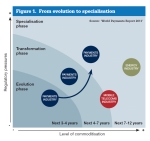Capgemini: Produce or deliver - the payments evolution – Jean Lassignardie and Simon Newstead
According to the 'World Payments Report 2011', the dawn of a new technological, economic and regulatory era is fast approaching. Capgemini's Jean Lassignardie, global head of sales and marketing, global financial services, and Simon Newstead, MD of market & business strategy, financial institutions, global transaction services at RBS, explain how this could change the make-up of the payments industry forever.
Banks are used to ongoing shifts in the payments landscape, but they now face a wave of new challenges from key regulatory and industry initiatives (KRIIs). These initiatives, driven by customer requirements, economic and competitive conditions, technology advances and regulatory pressure, are accelerating the transformation of the payments value chain; banks must decide how best to respond today in order to be well positioned tomorrow.
Capgemini's 'World Payments Report 2011' examines how these KRIIs may impact payments, considers the consequent strategic challenges and options for banks, and outlines recent trends in payments volumes and instruments usage.
The pressure on the payments industry has intensified since the financial crisis, and KRIIs are converging to reshape aspects of the market and the positioning of participants.
Most notably, industry forces of specialisation and commoditisation are already evident and intensifying, and KRIIs could spell change in both the operational standards and economics of many payments business lines. Payment options are also proliferating - especially as an increasing number of non-bank players emerge, often bypassing existing providers to engage customers directly.
Differentiate to accumulate
In this environment, banks and other payment service providers (PSPs) must distinguish their propositions, prove their value and energise trade. To ascertain where value pools will lie in the future payments market, it is useful to consider other network industries that have experienced similar evolutionary pressures.
For payments, that means looking at other network industries in which regulation, liberalisation, commoditisation and technological advances have converged in a similar way. Two prime examples are energy and telecoms: in these industries, the forces of change have driven service providers to distinguish themselves and their propositions through innovation.
In both cases, as underlying products and services became more standardised, the industry value chains disaggregated. In the process, the production and distribution ends of the value chain became polarised and specialist models emerged to cater to the unique needs at each end of the chain. It seems possible that this type of value-chain disaggregation could also occur in payments, resulting in new forms of business specialisation:
- basic payments production, which would require operational excellence, volume scale and cost leadership
- value-added services (VAS) distribution, which would require a deep understanding of customers, and the ability to build a distinctive set of products and services.
Further extrapolating this hypothesis, a radical transformation in which many PSPs specialise as either payments wholesalers or retailers could ultimately occur.
In this scenario, most banks may find it is no longer optimal to operate using the traditional 'produce-to-deliver' model, in which they cover the entire payments' value chain - from developing propositions, producing payments and managing client relationships through to offering other client services (although most use partners such as automated clearing houses for clearing and settlement).
Payments: on the brink of transformation?
Today the payments market is arguably still in the 'evolution phase' (see figure 1, above right). The pressure of both exogenous and endogenous forces is beginning to build upon the industry, as well as on the processes supporting the produce-to-deliver model.
In the short term, the effects of regulation, standardisation and commoditisation seem likely to push the payments business toward the 'transformation phase', strengthening the need to review existing models and strategies.
Ultimately, in seven to 12 years, as the drivers of change exert continued pressure, the payments industry could potentially enter a 'specialisation phase' in which business and delivery models become more specialised in particular segments of the value chain.
This would be similar to the development path of other network industries, such as energy and telecoms, where value-chain polarisation has occurred, driving market players firmly towards one end or the other (production vs distribution) depending upon their characteristics, capabilities and strategies.
If payments were to experience a similar kind of transformation, over the coming decade a real paradigm shift could occur.
This would potentially result in banks moving from the integrated produce-to-deliver model to a more industrial 'produce-or-deliver' model, and causing substantial disaggregation and restructuring of the industry value chain in the process.
The new order
In the new paradigm, traditional and potentially new segments could be managed by specialists, which would have to interact to provide end clients with VAS.
The two roles that might potentially emerge in the mid-to-long term are:
- wholesale payments providers (WPPs): upstream specialists who concentrate on operations processing, clearing and settlement, and possibly some parts of basic payments instruction. WPPs would need to seek volume and scale, and develop cost-focused sourcing strategies and operational excellence. Industry concentration is inevitable under this hypothesis, so WPPs would most likely be those large global/regional banks (and automated clearing houses) with the ability to produce basic payments services at a much lower price than smaller local/regional banks, and offer outsourcing to them
- retail payment services providers (RPSPs): downstream specialists who focus on one or a few of the client-facing segments of the value chain. RPSPs would buy basic payments from WPPs, bundling them with additional services to provide sophisticated VAS, and capturing value by leveraging their customer relationships and industry know-how. Banks partnering with vendors and industry specialists to improve their end-client services would most likely emerge as RPSPs.
Critically, even in this radical restructuring, there would be value in payments at both ends of the value chain (upstream and downstream).
As banks and other PSPs determine which role(s) they want/are able to play and accordingly position themselves for the long term, devising a clear strategy and business vision, and managing potentially complex transformation programmes will be the keys to success. Sourcing strategies, partnerships and enabling platforms, such as Payments Hubs (detailed in the 'World Payments Report 2010'), will also be vital.
Non-bank PSPs (in particular the 'over-the-top' players such as Google, Amazon, Apple and Facebook) also have
the potential to increase their focus on the retail payments business by, for example, interacting with the WPPs, broadening their offerings and increasing competition.
In particular, mobile telecoms operators might easily position themselves progressively more firmly in the person-to-person (P2P) space.
Act now
These dynamics illustrate how fundamental innovation will be to the future success of banks and other PSPs in delivering and creating both short and long-term value.
Many players may need to stretch beyond their comfort zones when positioning themselves for longer-term success, even though other opportunities may remain clearly in their sights at present.
In the short term, banks will need to invest in innovation and emerging technologies in order to compete or partner with more agile non-bank PSPs and players from adjacent industries, including retail, distribution and telecoms.
In this sense, mobile payments will be an important tool for many banks if they hope to develop some of the more promising business segments and remain competitive in future.
Whatever their chosen path over the next decade, banks and other PSPs will need to consider their existing infrastructure, user preferences, and capabilities and ambitions. Only then can they effectively develop an integrated business plan that will realise the true value of payments in light of the radically evolving landscape.



